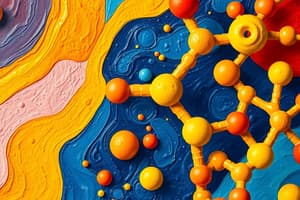Podcast
Questions and Answers
What are macromolecules?
What are macromolecules?
- Vitamins and minerals
- Large organic molecules used by the body for everyday functions (correct)
- Simple sugars
- Hormones
What are carbohydrates composed of?
What are carbohydrates composed of?
Carbon, Hydrogen, Oxygen
What is the monomer of carbohydrates?
What is the monomer of carbohydrates?
Monosaccharide
What is the polymer of carbohydrates?
What is the polymer of carbohydrates?
What are the main functions of proteins?
What are the main functions of proteins?
What is the monomer of proteins?
What is the monomer of proteins?
What is the polymer of proteins?
What is the polymer of proteins?
What are lipids used for?
What are lipids used for?
What is the monomer of lipids?
What is the monomer of lipids?
What is the polymer of lipids?
What is the polymer of lipids?
What are nucleic acids made of?
What are nucleic acids made of?
What is the monomer of nucleic acids?
What is the monomer of nucleic acids?
What foods are good sources of protein?
What foods are good sources of protein?
What foods contain carbohydrates?
What foods contain carbohydrates?
What foods contain lipids?
What foods contain lipids?
What foods contain nucleic acids?
What foods contain nucleic acids?
What does the chemical structure of a carbohydrate look like?
What does the chemical structure of a carbohydrate look like?
What does the chemical structure of a lipid look like?
What does the chemical structure of a lipid look like?
What does the chemical structure of protein look like?
What does the chemical structure of protein look like?
What does the chemical structure of DNA look like?
What does the chemical structure of DNA look like?
What does the chemical structure of RNA look like?
What does the chemical structure of RNA look like?
Study Notes
Macromolecules Overview
- Macromolecules are essential biological molecules: carbohydrates, proteins, lipids, and nucleic acids, vital for body functions and overall health.
Carbohydrates
- Composed of carbon, hydrogen, and oxygen.
- Primary function: provide energy for bodily activities.
- Common food sources: bread, pasta, sweets.
- Monomer: monosaccharide; polymer: polysaccharide.
Proteins
- Made up of carbon, hydrogen, oxygen, nitrogen, and sometimes sulfur.
- Functions: transport substances, catalyze reactions (enzymes), provide structural support, and produce hormones.
- Monomers: amino acids; polymer: proteins.
Lipids
- Include carbon, hydrogen, and oxygen.
- Monomer: fatty acid; polymer: triglycerides.
- Functions: energy storage, insulation, water resistance, and organ protection.
Nucleic Acids
- Composed of nitrogen and phosphorus.
- Types: DNA and RNA, responsible for storing genetic information.
- Polymer: nucleotide; monomers include ribose (in RNA) and deoxyribose (in DNA).
Monomers and Polymers
- Monomers are the fundamental building blocks of polymers.
- Polymers are large organic molecules formed from monomers.
Specific Terms
- Monosaccharide: the simplest carbohydrate monomer.
- Polysaccharide: complex carbohydrate polymer.
- Amino Acids: monomers that compose proteins.
Enzymes
- Enzymes are proteins that accelerate chemical reactions within the body.
Chemical Structures
- Carbohydrates: structural representation resembles a sideways hexagon.
- Lipids: visually resemble a backward uppercase "E."
- Proteins: simple representation appears as a plus sign; complex forms look like intertwined ribbons.
- DNA: spiraled ladder-like structure; composition varies by color-coded monomers.
- RNA: half spiraled ladder structure.
Food Sources
- Proteins: found in meats, eggs, nuts, fish, beans, and dairy products.
- Carbohydrates: present in potatoes, bread, pasta, fruits, and sweets.
- Lipids: sourced from dairy, oils, butter, fatty meats, and fast food.
- Nucleic Acids: primarily found in fish.
Studying That Suits You
Use AI to generate personalized quizzes and flashcards to suit your learning preferences.
Description
Explore the essential roles macromolecules play in human health and energy. This quiz focuses on carbohydrates, proteins, lipids, and nucleic acids, providing insights into their functions and structures. Brush up on your knowledge of these vital biological components!




